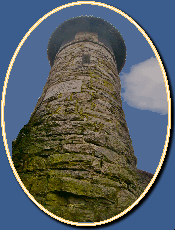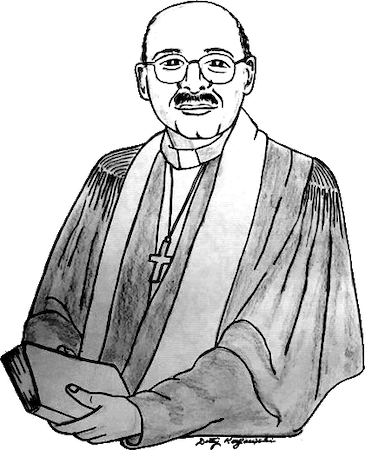1903-1989
The First Baptist Church was founded by African Americans from Milford in 1893 that had previously traveled by wagon to worship at Immanuel Baptist Church in New Haven. Services for their first 7 years were held upstairs from a Daniel Street store. The Baptists moved to a 100 year old shoe factory on North Street. They converted the upstairs into their own “house of prayer.” They purchased and converted a store, once Danon's Delicatessen, also on North street, which would be their home for decades. On the same lot, the current three times larger church building, commenced in 1965, was finished. Walker stated the "builder and maker is God” (with interior furnishings from other Connecticut churches).
Born in Triboro, North Carolina on December 7 1903, Charles Walker was orphaned at three and raised by an uncle to age 14. Thereafter he supported himself through to graduation from Hampton Institute, an African American college there.
He worked as a cook and butler in the home of New York businessman William H. Wheelock. During his first week employed at the residence as the only African American, Walker was treated differently by other workers who separated and sanitized anything touched by him. Upon learning this, his boss, impressed by his intellect, put Walker in charge of those same help. When his boss’ company at 67 Wall Street expanded in 1922, Walker became an executive managing real estate properties in Harlem. In the midst of the Great Depression, he entered his “wandering phase” where he briefly lived in Washington D.C. before settling in the Milford-New Haven area around 1950 to work at aircraft companies.
Charles Walker’s assuming the life of a spiritual leader “was the farthest from my mind.”
In 1961, Walker’s experience in living of raising a family and success in business made him ideal to “serve the community.” In 1958 at age 56, Charles Walker had his calling to the ministry of Milford’s small congregation of about two dozen. A year later his step-daughter Marion Taylor followed the call organizing gospel singers in New Jersey. The church lacked the ability to pay what a larger church could afford. During his years leading First Baptist Church he also was a personal manager for the Hunt-Pierce company.
Rev. Walker sought to build a society “without barriers of race creed, or condition.”
He opposed “unhealthy attitudes” that fostered discrimination, envy, resignation and silence in the face of injustice, especially for all marginalized groups. In the 1960s and 1970s, Walker faced unfair banking and real estate practices such as redlining where housing discrimination often made it "virtually impossible for a black man to rent or buy wherever he wished, even with money and good credit rating. Rev. Walker was encouraged by those “committed to the task of making a better world.” Undaunted,
his first house was in a pleasant mixed neighborhood bordering a commercial zone.
In June 1962 Walker planned organizing a “Christian anti-Communist” group at his church. A year later a mixed race group of 14 people were among the first from Milford to speak up about their experiences traveling by bus to hear Martin Luther King at the March on Washington. Once back in Milford, Reverend Walker led all faiths from a platform outside the old Church in a “Call to Conscience and Action” for northern cities to be part of the civil rights movement. The 200 gathered included civic leader Thomas Parsons, future mayor Alan Jepson and representatives of two local interracial groups.
Commemorating the bicentennial in 1976, he led efforts to commemorate Connecticut's African Americans in the Revolutionary War including nine from Milford. A stone monument with each man's name inscribed stands in front of the North Street Church.
He solved problems working towards envisioning an integrated church. Everyone gained a better understanding of each other while they worshiped and sang together. In 1968 the soft-spoken reverend called for “application of the methods so ably expressed and nobly practiced by Dr. King” at a joint service of Milford’s churches where all walks of Milford joined in harmony.
Rev. Walker feared a lost generation of children leaving Milford for lack of opportunity.
Some Milford families in 1968 and 1969 under Project Concern, invited the 25 African Americans children into their homes who were bused from poor areas of New Haven. Others served as “Emergency moms” for those enrolled across Milford’s grammar schools. Milford did not see much of the kind of racial turmoil many other cities experienced during the 20 years Walker served God and the city. When Walker retired after almost 20 years of service, the church’s faithful flock had grown to over 5 times larger than when he began.
Walker was well-read and produced a wide range of written and recorded material. Besides sermons, his poetry was printed when he was only 20 and his unpublished novel "Unknown Journey," was written in the 1930’s. Shortly before his death on February 16, 1989, Walker donated newspaper articles, personal documents and audio recordings to the highly regarded Schomburg Center in New York for its scholarly records. Schomburg describes Walker’s papers as evidencing the “experience of African Americans in small Northern towns where they constituted only a small minority of the population.”
The accomplishment Walker was most proud of was that the goodwill extended by Milfordites towards building the new church continued long after the physical building was completed. A moderate and thoughtful man, The Reverend listened to gauge differing viewpoints on issues, gaining understanding, then offering a measured response to resolve conflicts. He felt “If we get rid of black and white prejudices, it would be like cleaning out the swamp that breeds the mosquitoes.”
Walker was involved in the community as treasurer for the Milford Council of Aging, vice-chairman for the Red Cross and a United Way board member. His church donated offering collections to Milford needs like Rape Crisis Center.
Maps from 1835 refer to the glacier kettle pond between Meadow Side Road, Turnpike Road (Bridgeport Avenue) and Bear Neck Lane (Seaside Avenue) as Negro’s Pond. One legend states the name was in remembrance of a black boy who drowned there in the 1800s. Another tale states it was where domestic staff around Milford Center were allowed to skate. Some long published references to "Neg's" Pond or worse were considered disparaging. The African American families in Milford in the 1960s didn’t publicly contest the pond’s old monikers. Walker noted in 1970 that many African Americans were quiet with the attitude that “this is a situation I will not disturb as long as I have some semblance of peace and security.” The possible slights were resolved in January 1995 when the pond was renamed Walker’s Pond in well deserved honor of the Reverend Walker.



